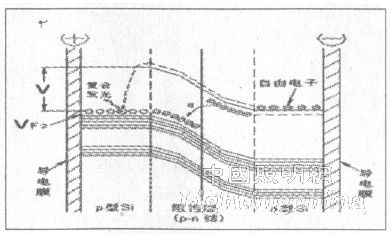
Privacy statement: Your privacy is very important to Us. Our company promises not to disclose your personal information to any external company with out your explicit permission.

1 Principle process of white LED operation
The illuminating process of the white LED of the current structure is carried out in two steps. After the power is turned on, the carrier composite illuminating in the LED chip is first, and when the blue photon emitted by the chip is coated by the phosphor of the output window, some of the blue photons are used. Direct transmission, the remaining part of the blue photon is quantum down-converted to yellow light, so the white LED light source outputs blue and yellow mixed quasi-white light.
2 Carrier Composite Luminescence in LED Chips
The illuminating process of the LED chip is the carrier recombination process in the chip. After the power is turned on, the free electrons in the n-type semiconductor layer in the chip enter the p-type semiconductor layer under the acceleration of the electric field of the barrier layer, and recombine with the holes therein (see FIG. 1), and simultaneously release the electric field from the barrier layer in the form of photons. The total energy of the free energy plus the original kinetic energy of the free electrons. If the potential difference of the barrier layer is V, the electron charge is e, and the original kinetic energy of the electron is mv2/2, the photon energy released when the carriers are recombined is the sum of the two, that is, eV+mv2/2, which is originally possessed by the free electrons. The kinetic energy is not consistent, and its law is consistent with the Fermi distribution. Therefore, the blue spectrum of the LED radiation has a certain bandwidth, and its center wavelength is equivalent to the barrier potential difference, and the bandwidth is determined by the free electron kinetic energy.

Figure 1 Carrier composite luminescence
The material currently used for blue-emitting LED chips is GaN. The barrier potential of this LED chip is V≈2.62-2.74eV, which is related to materials, structure, epitaxial process, processing temperature, working environment and operating temperature. The principle structure of a GaN-based LED chip is shown in FIG.

Figure 2 Principle structure of the LED
Since the barrier potential of the LED is 2.62 to 2.74 eV, a blue spectral band having a center wavelength of 450 nm to 470 nm is emitted, and the emission spectrum is as shown in FIG. Figure 3 shows that the blue spectral band is very narrow and the entire band is in a region where the visual function is below 0.1 and the light efficiency is very low. This low-light, low-color blue spectral band is not directly usable for general illumination.

Figure 3 Blue light spectrum emitted by LED
3 Light quantum down conversion of phosphor in white LED
The white LED actually uses a part of the blue light emitted by the LED to excite the yellow light phosphor to generate a certain amount of yellow light, thereby obtaining a quasi-white light mixed with blue and yellow light. The spectrum of such a white LED emission is shown in Figure 4. It can be seen from the spectrum that green light and red light are lacking, especially the proportion of red light is too small, so the white light LED has a low color rendering index and a high color temperature.

Figure 4: Mixed spectrum of blue LED excited yellow light phosphor
Adjusting the phosphor coating thickness adjusts the blue and yellow ratio to adjust the luminous efficacy and color temperature of the irradiated quasi-white light. The results of this test are shown in Figure 5 and Table 1. In the test, the thickness of the phosphor coating of the four samples increased by about 15%, and the results showed that the thickness of the phosphor coating of the test III was moderate, and the obtained light effect, color rendering index and color temperature were far better than other thicknesses. 40lm/w) and similar to the actual product parameters. When the phosphor coating is thin (I, II), the yellow component is too small, the color temperature is high, and the light efficiency and luminous flux are both low. When the phosphor coating is too thick (IV), although the low-efficiency blue light is all converted into a yellow light with a high apparent function, the blue light completely disappears from the spectrum, and the luminous flux should be high, but the actual luminous flux is drastically reduced. It is. This indicates that the phosphor coating absorbs a large proportion of blue and yellow light while performing photon down conversion. The thicker the coating, the more complete the photon down conversion, but the more photons are absorbed. When the coating exceeds the optimum thickness, the light output is naturally reduced, so the thickness of the phosphor coating must be strictly controlled, otherwise the lamp parameters, especially the light effect, will be greatly affected.

Figure 5 Effect of phosphor thickness on light parameters

Table 1 Effect of phosphor thickness on light parameters
WOSEN is a professional manufacturer and supplier of Led Flood Light, Led Street Light, Led Solar Light, etc. For more information, please visit https://www.wosenled.com/ or contact admin@wosenled.com or WhatsApp +86-13425434349
Edit: Cedar
Wyślij je do tym dostawcy

Privacy statement: Your privacy is very important to Us. Our company promises not to disclose your personal information to any external company with out your explicit permission.

Fill in more information so that we can get in touch with you faster
Privacy statement: Your privacy is very important to Us. Our company promises not to disclose your personal information to any external company with out your explicit permission.